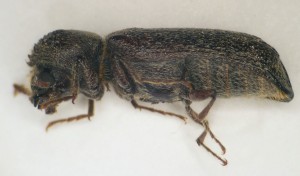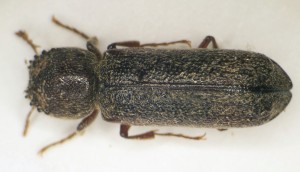Symptoms Management Life Cycle More Info
Phil Mulder, Oklahoma State University
Symptoms
Damage from the grape cane borer consists of perfectly round holes (about 1/8-inch in diameter) drilled just below or above the bud or node of grape plants. Younger plants are most susceptible, but older plants can also be attacked. While damaged or dying vines and trees are usually attacked, the beetles will also bore into living, healthy tissue of stressed vines. Plants that were in good shape prior to attack will begin to wilt, droop and never look as healthy as adjacent uncompromised plants. These infested plants may not die immediately, because the entire vascular system of the plant has not been disrupted; however, they will never catch up to the healthy plants. The problem often goes unnoticed because of the timing of their emergence and size and position of their exit holes. The exit hole is generally located near a bud (either just above or below) and they are only about 1/8- to 3/16-inch in diameter.
Management Options
Control this devastating pest using an integrated program.
- Keep all plant material healthy and well-fertilized.
- Eliminate wild grapes or other hosts near the vineyard.
- Routinely collect and burn any infested branches, broken limbs, and prunings.
- Apply insecticide if you have a widespread proliferation of beetles.
Total control will continue to be a challenge with the prolonged emergence pattern of beetles. Sanitation (burning) and exclusion (eliminating wild hosts) are the best long-term solutions to this potentially recurring problem.
Life Cycle
Adult activity occurs in early spring and fall, although there is only one generation per year. Adults lay eggs in the bark of twigs and small branches. After hatching, the larvae burrow into the twig, generally straight to the pith and tunnel along this path, packing the frass (insect excrement) behind them. In the fall, larvae mature and pupate within the larval tunnel. They may or may not transform into adults, but usually hibernate inside the larval gallery in winter. Some adults will actually emerge and later enter another cane when winter sets in. All adults will emerge in spring from March through May and repeat the cycle.
The grape cane borer has an incredibly wide host range, attacking pecan, peach, plum, apricot, pear, ash, butternut, hickory, maple, apple and grape.
Recommended Resources
 Grape Cane Borer, Cornell University
Grape Cane Borer, Cornell University
 Grape Cane Borer, University of California
Grape Cane Borer, University of California
 Grape Cane Borer, University of Minnesota
Grape Cane Borer, University of Minnesota
Midwest Small Fruit and Grape Spray Guide
Field Guide for Integrated Pest Management in Pacific Northwest Vineyards, Washington State University
Reviewed by Eric Stafne, Mississippi State University and Bruce Bordelon, Purdue University




